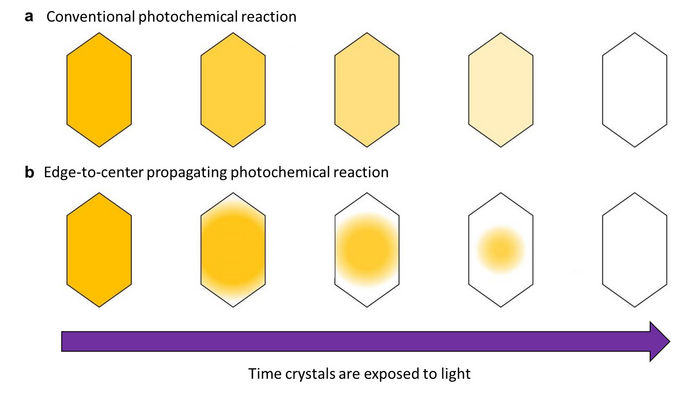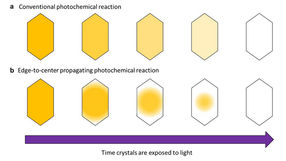Discovery overturns major assumptions in crystal photochemistry!
Molecular crystal exhibits propagation of photochemical reaction
Stimuli-responsive materials, whose physical properties change in response to external stimuli such as light and heat, are being widely studied as next-generation functional materials. Especially, photo-responsive materials are attracting much attention because their physicochemical properties can be modulated remotely without any physical contact. As one of the photo-responsive materials, photomechanical molecular Crystals, which consist of molecules that undergo photochemical reactions upon light irradiation, are being intensively investigated because of their unique photoresponsive behaviors.

Symbolic image
Computer-generated image

Photochemical reactions were thought to occur uniformly so that when light shines on crystals evenly, they change color evenly. But a research group at Osaka Metropolitan University has discovered that a photomechanical molecular crystal, 2,5-distyrylpyrazine (DSP), undergoes photochemical reactions differently, with the color change spreading from the crystal’s edges and propagating to its center.
Daichi Kitagawa, Osaka Metropolitan University


Unlike in solutions where molecules exist independently, the molecules are arranged densely and regularly in crystals, so the unique photoreaction dynamics in crystals must be considered. However, previous studies on photoreactive molecular crystal materials have usually assumed that photoreactions in crystals proceed like those in solutions and follow classical photoreaction kinetics. So, understanding of physicochemical property changes based on the photochemical reaction kinetics in crystals has been an issue for further development of this research field.
A research group led by Kohei Morimoto, a third-year doctoral student at the Osaka City University Graduate School of Engineering, and Dr. Daichi Kitagawa and Professor Seiya Kobatake at the Osaka Metropolitan University Graduate School of Engineering has discovered that photoreactions in 2,5-distyrylpyrazine (DSP) crystals propagate from each of the crystal’s edges to its center. The research results were published online in Angewandte Chemie International Edition on November 3, 2022.
Normally, when light shines evenly on a crystal, the color change caused by the photoreaction also proceeds evenly. However, the research group found that in DSP crystals, the color change started at the crystal’s edge and proceeded to its center, propagating the photoreaction like a wave. The research group determined that this edge-to-center propagation of the color change happens for two reasons: a surface effect, which makes reactivity extremely high at the edges of the crystal, and a cooperative effect, which also elevates reactivity for molecules whose neighbors have already changed color.
“This phenomenon, which deviates from the conventional conception of photochemistry, is hugely significant for how we understand the basic fundamental science of photoreactions,” said Dr. Kitagawa. “In the future, we would like to clarify the conditions necessary for this unique photoreaction to occur and explore how they can be used to create new functional materials that take advantage of this phenomenon.”
Original publication
Other news from the department science

Get the chemical industry in your inbox
By submitting this form you agree that LUMITOS AG will send you the newsletter(s) selected above by email. Your data will not be passed on to third parties. Your data will be stored and processed in accordance with our data protection regulations. LUMITOS may contact you by email for the purpose of advertising or market and opinion surveys. You can revoke your consent at any time without giving reasons to LUMITOS AG, Ernst-Augustin-Str. 2, 12489 Berlin, Germany or by e-mail at revoke@lumitos.com with effect for the future. In addition, each email contains a link to unsubscribe from the corresponding newsletter.




























































